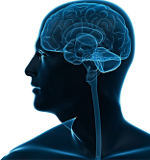Innovative Public/Private Partnerships Accelerate Brain Injury Research
The “BRAIN” initiative, which stands for Brain Research through Advancing Innovative Neurotechnologies, is already underway at the National Institute of Health (NIH). And, on April 2, 2013 President Obama announced that his 2014 budget will include $110 million in funding to advance the initiative, which supports human brain research that could be used to treat a range of neurological conditions, including traumatic brain injury (TBI).
I expect the additional funds to elevate the project’s urgency, as it would be a joint effort of the National Institutes of Health, the Defense Advanced Research Projects Agency (DARPA) and the National Science Foundation along with other private and public entities. If this initiative goes forward, it also promises to augment work already underway at other research centers throughout the country.
 Click on the image to see enlarged. To learn more about the President Obama’s support for the BRAIN initiative, reference the White House issued “Fact Sheet,” here.
Click on the image to see enlarged. To learn more about the President Obama’s support for the BRAIN initiative, reference the White House issued “Fact Sheet,” here.
What this means to you
It’s no surprise that advances in brain science are already making it easier to prove the existence of a TBI, understand its prognosis, and provide more effective interventions and rehabilitation. Further, interest in brain injury and private investment in research has been accelerated by a new and greater attention to the plight of athletes and veterans who have suffered TBIs.
For example, in March 2013 the NFL and General Electric Co. (GE Healthcare) announced a $60 million initiative to develop and improve concussion detection imaging for athletes, the military and the general population.
The Milwaukee Business Journal reported that:
“The partnership represents the NFL’s biggest private-industry partnership so far and follows increased attention on the long-term effects of brain injuries on current and former players. The GE initiative is just one of the steps the NFL has taken recently to reduce head injuries.
While the focus of the partnership with the NFL is to improve player safety, many other sports are affected by traumatic brain injury, including hockey, lacrosse, cycling, and snowboarding. In addition, people involved in traffic accidents or suffering from neurological abnormalities may also benefit from the insights garnered in the new partnership, GE said.”
National and State Based Brain Injury Associations are Leading Grass Roots Advocacy Efforts
The oldest and most active advocacy groups acting on behalf of all TBI victims are the national and state based brain injury associations (BIAs). The scope of their diligent work covers all aspects of advocacy from prevention and treatment to legislative initiatives. (Reference the Brain Injury Association of America)
State-based BIAs typically provide direct support to TBI victims through programs like Information and Referral, Neuro-Resource Facilitation, and support group coordination. (I know first hand the value of the work BIAs do, as yours truly is one of the founding board members of the Brain Injury Association of Vermont.)
BIAs are determined to serve not only the victims of TBI who have received public attention, like veterans and athletes, but also the less visible victims, such as those who are incarcerated in criminal institutions, where a history of TBI is surprisingly common.
“Why Brain-Injured Defendants in Vermont Often Go Free,” a March 20, 2013 article written by Ken Picard for Vermont’s most popular weekly paper, SEVEN DAYS, documents the phenomenon.
“How common are TBI victims in the criminal justice system? Brain injury experts say they’re much more common than the public or court personnel realize.
 Last year, the legislature asked the Vermont Department of Corrections to compile a report on the number of inmates suffering from a “severe functional impairment,” which can include dementia, mood or personality disorders, psychoses and TBIs. As of September [2012], 121 offenders in state custody were known to have severe functional impairment. Only two were on the list for a known TBI.
Last year, the legislature asked the Vermont Department of Corrections to compile a report on the number of inmates suffering from a “severe functional impairment,” which can include dementia, mood or personality disorders, psychoses and TBIs. As of September [2012], 121 offenders in state custody were known to have severe functional impairment. Only two were on the list for a known TBI.
Screening for TBIs, especially mild ones, is difficult, expensive and not done routinely by the Department of Corrections or Probation and Parole. And TBI experts suggest that many inmates don’t realize that the root cause of their antisocial behavior is a blow to the head they received years ago.”
We are entering an era of new technologies, public and private funding, and greater public exposure for a condition that impacts individuals, families, loved ones and society in general. The outlook is hopeful. Please subscribe to the Brain Injury Blog for current updates summarizing new developments.

